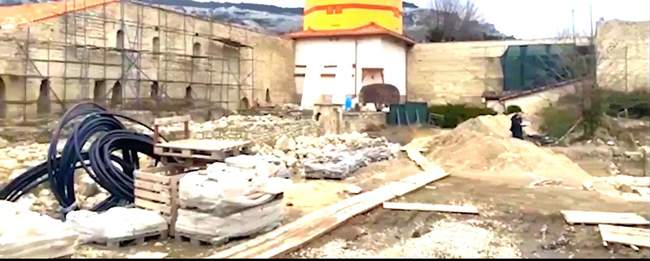Меню
Social networks
Sections
March 7, 2025, 11:14 a.m.
Russian Occupiers Destroy Unique Frescoes at Khan's Palace in Crimea
Цей матеріал також доступний українською186

Photo: Screenshot from the video
In the temporarily occupied Crimea, Russian "restorers" destroyed unique frescoes while working on the Khan's Palace in Bakhchisarai.
According to NEXTA Live, the builders who came across the valuable historical painting simply destroyed it. It is no longer possible to restore the frescoes.
All this became possible because the occupiers did not involve professional restorers but hired cheap labor without experience with cultural monuments.
The Khan's Palace is the only example of Crimean Tatar palace architecture in the world included in the preliminary UNESCO World Heritage List. However, due to the actions of the occupation authorities, it is turning into ruins.
Earlier, Intent wrote that in Crimea, the occupiers completely destroyed the UNESCO World Heritage Site of Tauric Chersonese in Sevastopol.
A significant part of the artifacts found there were taken to Russia: frescoes, dishes, household items and icons. The construction of the NewChersonesos archaeological park has since begun on the site of the necropolis.
Also in the Kherson region, where there were more than 10,000 historical and cultural monuments before the full-scale invasion, the Russian occupiers are destroying the archaeological heritage by building fortifications.
Thus, the occupied left bank of the Dnipro River, which remains under Russian control, has the highest number of losses.
In particular, the Lyubymivske Late Scythian settlement, dating from the second century BC to the fourth century AD, has been turned into a military position. Archaeological sites, such as mounds, are excavated to build observation posts and fortifications. As a result, unique cultural layers are being destroyed forever.
Odesa, Mykolaiv, and Kherson regions are among the ten regions where cultural heritage sites have suffered the most due to Russian aggression.
In July, the total number of affected sites increased by 11. Currently, 1096 cultural heritage sites have been damaged.
Of these, 121 are of national importance, 892 are of local importance, and 83 are newly discovered.
Thus, 314 sites were damaged in Kharkiv region, 150 in Kherson, 125 in Donetsk, 116 in Odesa, 69 in Chernihiv, 69 in Kyiv and Kyiv city, 49 in Zaporizhzhia, 45 in Mykolaiv, 39 in Dnipro, 36 in Lviv, 31 in Luhansk, 27 in Sumy, 10 in Khmelnytsky, 6 in Poltava, 4 in Vinnytsia, 4 in Zhytomyr, 1 in Kirovohrad, and 1 in Cherkasy.











